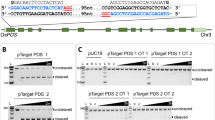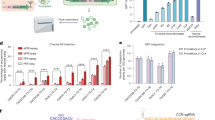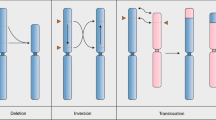Abstract
Agrobacterium transfer DNA (T-DNA) is an effective plant mutagen that has been used to create sequence-indexed T-DNA insertion lines in Arabidopsis thaliana as a tool to study gene function. Creating T-DNA insertion lines requires a dependable method for locating the site of insertion in the genome. In this protocol, we describe an adapter ligation-mediated PCR method that we have used to screen a mutant library and identify over 150,000 T-DNA insertional mutants; the method can also be applied to map individual mutants. The procedure consists of three steps: a restriction enzyme-mediated ligation of an adapter to the genomic DNA; a PCR amplification of the T-DNA/genomic DNA junction with primers specific to the adapter and T-DNA; and sequencing of the T-DNA/genomic junction to enable mapping to the reference genome. In most cases, the sequenced genomic region extends to the T-DNA border, enabling the exact location of the insert to be identified. The entire process takes 2 weeks to complete.
This is a preview of subscription content, access via your institution
Access options
Subscribe to this journal
Receive 12 print issues and online access
$259.00 per year
only $21.58 per issue
Buy this article
- Purchase on Springer Link
- Instant access to full article PDF
Prices may be subject to local taxes which are calculated during checkout


Similar content being viewed by others
Change history
13 December 2007
In the version of this article initially published, the sequences for the three short strands listed in Table 1 (p. 2912) were incomplete. Each of the three should have started with “5'-Phosphate-” and ended with “-amino C7-3′ ”. The entry in the Comments section for each of the three sequences should have read: “5′ phosphorylated and 3′ C7 amino modification. HPLC purified". In the table footnote, “Blue text” and “Red text” should have been “Dotted underscore” and “Solid underscore” and the corresponding sequence segments in the table underscored appropriately. On the same page, a sentence was omitted from the third paragraph in the section “Adapter and primer design.” The third sentence should have been: "The short adapter has a 3′ C7 amino modification to prevent polymerase extension of the short adapter, as this would generate the latent primer-binding sites on all ligated molecules and not just those containing the T-DNA primer-binding site." Under “Reagents,” the entry for oligonucleotides should have included the name of the supplier, Operon. These errors have been corrected in the HTML and PDF versions of the article.
25 March 2010
In the version of this article initially published, the sequence shown in the top row (“Long strand of adapter 1”) of Table 1 was missing an adenosine at position 16. Instead of: GTAATACGACTCACTTAGGGCACGCGTGGTCGACGGCCCGGGCTGC, the sequence should have appeared as: GTAATACGACTCACTATAGGGCACGCGTGGTCGACGGCCCGGGCTGC. This error has been corrected in the HTML and PDF versions of the article.
References
Chilton, M.D. et al. Stable incorporation of plasmid DNA into higher plant cells: the molecular basis of crown gall tumorigenesis. Cell 11, 263–271 (1977).
Clough, S.J. & Bent, A.F. Floral dip: a simplified method for Agrobacterium-mediated transformation of Arabidopsis thaliana. Plant J. 16, 735–743 (1998).
Hiei, Y., Ohta, S., Komari, T. & Kumashiro, T. Efficient transformation of rice (Oryza sativa L.) mediated by Agrobacterium and sequence analysis of the boundaries of the T-DNA. Plant J. 6, 271–282 (1994).
Alonso, J.M. et al. Genome-wide insertional mutagenesis of Arabidopsis thaliana. Science 301, 653–665 (2003).
Liu, Y. et al. Efficient isolation and mapping of Arabidopsis thaliana T-DNA insert junctions by thermal asymmetric interlaced PCR. Plant J. 8, 457–463 (1995).
Sessions, A. et al. A High-throughput Arabidopsis reverse genetics system. Plant Cell 14, 2985–2994 (2002).
Schröder, A. et al. HIV-1 integration in the human genome favors active genes and local hotspots. Cell 110, 521–529 (2002).
Acknowledgements
This work was funded by the National Science Foundation (award numbers 0115103 and 0420126). We thank Cesar Barragan, Mary Galli, Dr Ryan Lister and Dr Brian Gregory for critical reading of this manuscript.
Author information
Authors and Affiliations
Corresponding author
Rights and permissions
About this article
Cite this article
O'Malley, R., Alonso, J., Kim, C. et al. An adapter ligation-mediated PCR method for high-throughput mapping of T-DNA inserts in the Arabidopsis genome. Nat Protoc 2, 2910–2917 (2007). https://doi.org/10.1038/nprot.2007.425
Published:
Issue Date:
DOI: https://doi.org/10.1038/nprot.2007.425
This article is cited by
-
Harnessing tissue-specific genome editing in plants through CRISPR/Cas system: current state and future prospects
Planta (2022)
-
The APAF1_C/WD40 repeat domain-encoding gene from the sea lettuce Ulva mutabilis sheds light on the evolution of NB-ARC domain-containing proteins in green plants
Planta (2022)
-
Toward the development of Ac/Ds transposon-mediated gene tagging system for functional genomics in oat (Avena sativa L.)
Functional & Integrative Genomics (2022)
-
Whole-genome resequencing using next-generation and Nanopore sequencing for molecular characterization of T-DNA integration in transgenic poplar 741
BMC Genomics (2021)
-
Strategies to produce T-DNA free CRISPRed fruit trees via Agrobacterium tumefaciens stable gene transfer
Scientific Reports (2020)
Comments
By submitting a comment you agree to abide by our Terms and Community Guidelines. If you find something abusive or that does not comply with our terms or guidelines please flag it as inappropriate.



